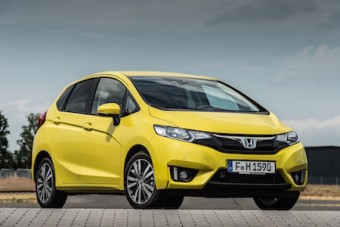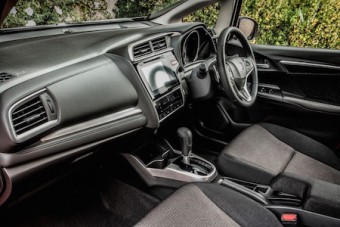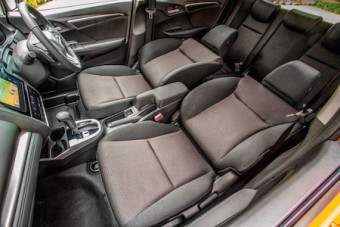
The new third generation Honda Jazz went on sale in September with a new 1.3-litre petrol engine, new larger platform, more interior space and smarter looks.
The re-styling now might improve the appeal to a younger group of family customers rather than the older generation who were its main users.
Prices will range from £13,495 to £18,035 following an average 2.3% increase from 4 January 2016. With no Honda season of goodwill in operation their Civic and CR-V models also increase in price by 2.3% and the recently introduced HR-V compact SUV by 4.4%. Not a good way to start the New Year Honda with a price increase!
Another reason for younger families to buy the new Jazz is the extra interior space. The overall length has gone up by 95mm to 4.0-metres which= means the wheelbase has increased by 30mm so improving leg room in the rear seats by 115mm. Shoulder room has increased by 30mm in the front and 20mm in the rear. The boot space has also increased by 17-litres giving it a volume of 354-litres with the rear multi-position ‘Magic Seats’ in use or up to 1,314-litres with them folded down flat.

The new and more spacious Jazz still competes against other supermini B-segment hatchbacks such as the Ford Fiesta, Skoda Fabia, Seat Ibiza and VW Polo. But its class leading space and versatile rear seating makes it more of a compact MPV so the competition also includes the Ford B-Max and the Citroen C3 Picasso.
The latest Jazz uses a new stiffer platform which is 12% lighter than its predecessor and it is shared by their HR-V compact SUV range and the front end styling is also the same. There are upgraded and lighter suspension components – MacPherson struts at the front and a torsion beam at the rear to provide a flat ride performance reducing pitching to the front and rear during acceleration and braking. New damper settings are utilized to reduce bumps from potholes and road noise being transmitted into the car.

Honda’s City Brake Active System is fitted as standard across the range. A new handling system has been used to reduce cornering understeer which completes the overall refinement of the driving and handling characteristics. Despite the changes there are still some thumps and bumps felt inside the car but generally the ride comfort is good and the handling well balanced. With disc brakes all round, coupled with the various on-board handling and safety systems, the new Jazz feels safe and secure but then its new 1.3-litre petrol engine is not too demanding on the car’s capabilities – but more of that later.
The overall exterior styling of the new Jazz retains the steeply raked front windscreen and A-pillars leading to a sculptured side profile, rising waistline and coupe roof-line which slightly lowers to the rear but doesn’t significantly reduce the headroom for rear passengers. At the rear is a wide opening near vertical tailgate complete with spoiler, wider wheelarches and sports style rear bumper which incorporates air-flow release vents and so looks more athletic and purposeful. The new exterior view should be more appealing to a younger buying audience.
Inside the cabin is light and airy thanks mainly to the large windscreen and despite the rising waistline the side windows are quite large. The slightly elevated seating positions, one of the main plus points of the previous Jazz, are retained so getting in and out of the vehicle even for the less mobile is comfortable. The steering column has an extra 10mm of reach adjustment and the driver’s seat travel adjustment is increased by 36mm.
The interior finishes have improved slightly and are mainly of soft-touch plastic with printed stitching joints and there is cloth upholstery for the seats. There are plenty of storage pockets positioned around the family-friendly interior. The fascia is now more driver focussed and on most models a 7.0-inch touchscreen is angled slightly towards the driver with the three main instruments positioned right in front of the driver. Some minor controls are hidden from view.

There are S, SE, SE Nav, EX and EX Nav spec levels and all but the base S version have the Honda Connect infotainment system fitted as standard. This provides internet browsing, access to real-time news, traffic and weather. The base S version specification includes 15-inch steel wheels, DAB radio, Bluetooth, cruise control, auto lights and wipers, Magic Seats, electric front and rear windows and air-con. SE additions include alloy wheels, Honda Connect, heated and electrically adjustable door mirrors, front and rear parking sensors and alarm. EX additions include 16-inch alloys, smart entry and push button start, rear view camera, front fog lights, auto air-con, leather steering wheel and gearknob and rear privacy glass. Nav spec adds Garmin sat-nav to SE and EX levels.
So far so good, more space, more equipment, better driveability and all wrapped up in a smarter and more youthful body. Now comes the core crunch. Honda has replaced the previous 1.2 and 1.4-litre petrol engines with a new variable valve timing non-turbocharged 1.3-litre, 102hp petrol unit. It might on paper be quicker than the old 1.4-litre engine, but compared to other new turbocharged EU 6 petrol engines available, it feels old-school. It lacks outright power and more importantly torque at a mere 123Nm (91lb ft) produced at a high 4,000rpm rather than near double that at 1,750rpm.
This new engine needs to be worked really hard to provide mid range response for overtaking slow vehicles and it gets very vocal under pressure. You find yourself continually changing down a gear to inject some response during acceleration. Once cruising speed has been reached it does hum along without stress until you meet an uphill section and then it’s down a gear again to maintain reasonable speeds. It is available with either a six-speed manual gearbox or a CVT automatic transmission.

Its revving noisy performance is off-set perhaps by the good fuel economy; 55.4mpg manual and 57.6mpg for the auto with the EX trim in the Combined Cycle. On my week long test the EX Nav model returned 52.2mph for 180-miles of motorway 70mph cruising and this went down to an overall average of 48.9mpg with some local short driving travel included. Its fuel economy is this engine’s saving grace. The CO2 emissions are 120g/km for the manual and 114g/km for the auto so VED road tax is £0 First Year rate and then £30 for Year Two onwards for both transmission versions.
Overall the new Honda Jazz is a significantly more stylish and certainly a much roomier car than its predecessors but it will be a letdown in the engine department in terms of driveability and a reasonable amount of performance. Honda really needs to adopt turbocharging for its smaller capacity petrol engines to keep up with the competition.
MILESTONES:
New Honda Jazz 1.3 i-VTEC EX Nav manual. Price: £16,935 (from 4 January 2016). Engine/transmission: 1.3-litre, 4-cylinder variable valve timing petrol, 103hp, 123Nm of torque at 5,000rpm, 6-speed manual. Performance: 118mph, 0-62mph 11.5-seconds, 55.4mpg Combined Cycle, (48.9mpg on test), CO2 120g/km, VED road tax £0/£30, BIK company car tax 19%. Insurance group: 13E. Warranty: 3-years/90,000-miles. Dimensions/ capacities: 5-doors, 4/5-seats, L 3,995mm, W 1,694mm, H 1,550mm, boot/load space 354 to 1,314-litres, braked towing weight 1,000kg.
For: Larger interior space and smart seating options, safety technology and equipment, sharper handling, comfortable ride, good real-life fuel economy and low taxation costs.
Against: Uncompetitive non-turbo petrol engine, price increase in January.
© David Miles

